Interview by Ruth Amelung // Apr. 04, 2016
I am sitting in a typical Kreuzberg café, white tiled with a wooden, slightly industrial interior flair. It’s just before noon on a grey Wednesday, but it isn’t very busy. An americano in front of me, I’m waiting for Derek Di Fabio and Isa Griese, better known as Daughters with Love Born in Cherimus Circus 2008. As this name is quite a mouthful, they abbreviated it to 2008daughters. They are a Berlin-based designer-artist duo who, since 2012, have been uniquely bridging the gap between art, performance and fashion. Their work and projects revolve around bodies and their processes. Having met in Milan in 2011 during a project called ‘Let’s Circus’ by Marco Colombaioni, which partly inspired their name, the pair decided to team up to find out what they could create together.
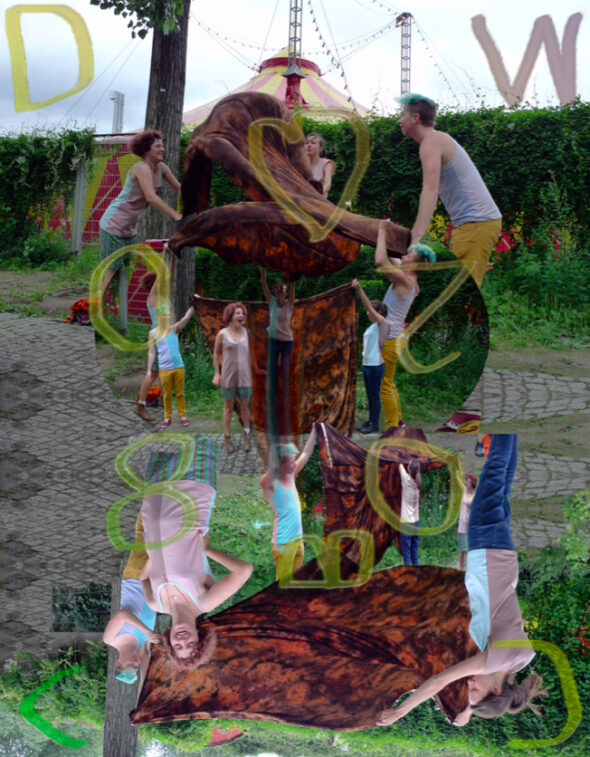
2008daughters: ‘Berlin Movers’, 2012 // Copyright: 2008daughters
Due to their different backgrounds, it’s an exciting challenge to try to define their work, even for the artists themselves. Griese is a trained fashion designer, accounting for their tendency towards including garments and fabrics in performances. Di Fabio’s roots are in performance art. The combination makes for something rather unusual.
One of their first projects, called ‘Berlin Movers’, grew from an idea for a movement: participants were walking around Görlitzer Park in Kreuzberg, wearing t-shirts made by Griese, orchestrated by Di Fabio and performing movements by people they are attached to. This was captured on camera, to see how or whether the movements could be relocated into lovers’ bodies.
Ruth Amelung: Your work is difficult to categorise or define, but you seem to be in the cross-section of performance, art and fashion. Was that the idea behind 2008daughters?
Derek Di Fabio: The idea was a piece of work that combines local identities with local materials, individuality rather than a heterogeneous group, with the view being fundamental, as an active part. In this process, the final result should be received as the slow production, that it was. Clothes were a starting point. We were also thinking about production sites, where people can physically come together and share knowledge, while they’re making clothes, for example.
RA: Do you consider your work to be fashion, art or performance?
Isa Griese: I don’t want to specify it. One time I called it a workshow not a workshop, as the show resulted out of our actions. And a show can be an exhibition, but it can also be a fashion show. Of course that’s also about the English language, but for me it’s not necessarily fixed.
RA: You most recently had garments exhibited at Duve, as part of Iris Touliatou’s ‘Can You Wash the Water’. Your collection was not being worn, but laid out to be looked at. Was that unusual for you?
IG: It was and somehow I thought it would more interfere with each other. Our collection was about cycling. She had canvases and sculptures and I think that worked, but I was expecting that some elements would have physically touched another. We made a few references to her work, for example. We had an actual print of a friend’s tattoo of a watch and put it on a cycling glove, a reference to one of Iris’s canvases.
DF: For this, we were thinking about clothes for cyclists specifically but there are also some influences from older projects that are visible in how we displayed the work.
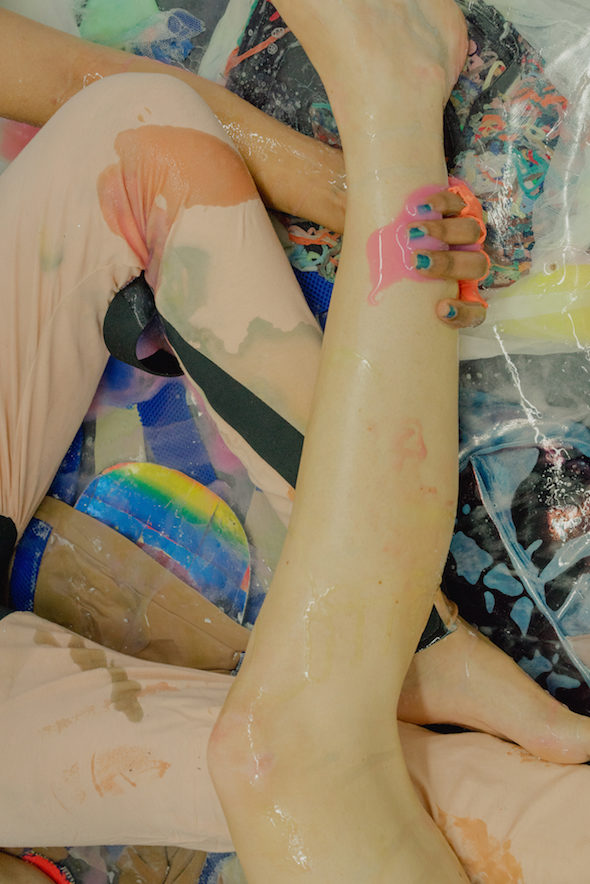
2008daughters: ‘Squash Every Week Into A Day’, 2016// Copyright: Bennie Julian Gay
RA: It also brings up the question if fashion belongs in galleries, or museums-like spaces such as Jean Paul Gaultier’s ‘From the Sidewalk to the Catwalk’.
IG: This question about fashion in galleries or museums came up for us, too. Does it belong there? Does it work? I remember these Comme des Garçons videos with models walking inside museums in Antwerp used as an answer to Rei Kawakubo‘s not giving a piece of clothing for a fashion exhibition. Fashion for her was to be shown on catwalks and when I think about fashion having various industrial and economical branches attached, then it leads me to questions about how clothes are actually produced.
RA: The body is an important starting point in fashion. What role does it play for you?
DF: For a project we did in Torino in 2014 called ‘Sew u!’ we made a sewing machine so that we could sew someone directly into a dress. A coordination of several elements and people were making wearable sculptures. The person lay down on the table and we sewed the dress straight on. So our work is objects or clothes, but they need the person: a body to complete them and bring them to life.
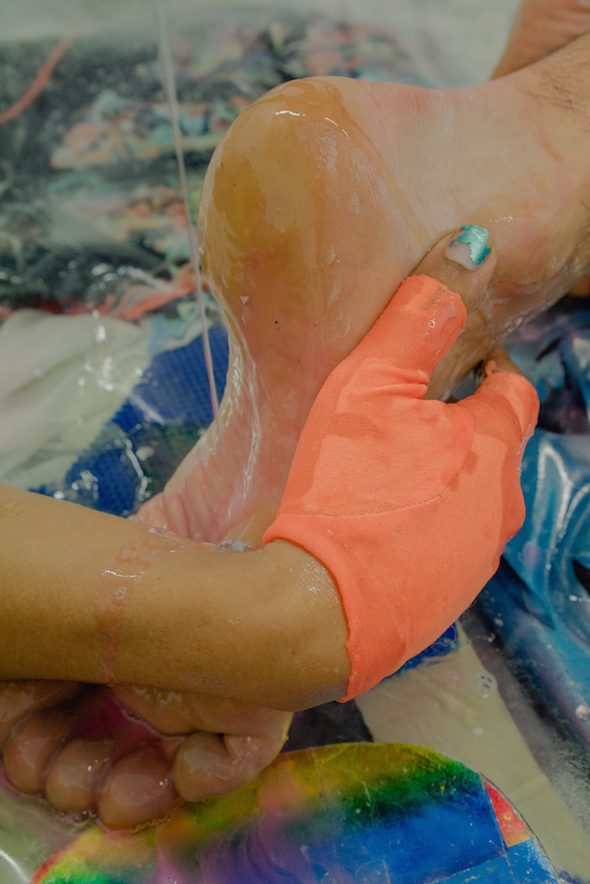
2008daughters: ‘Squash Every Week Into A Day’, 2016// Copyright: Bennie Julian Gay
RA: How does the idea process work? Where does your inspiration come from?
IG: For the cycling pants and gloves: I’m not sure how we came up with the whole collection, but we had the idea of doing something like that about two years ago.Polo Biker performers at Derek’s show Free Range Winter Banana at Pavillon social, Lucca, dressed in biker’s shirts made by us have been the first step of the cycling clothes. Sometimes, like the idea with the trolley and sewing someone into a t-shirt, it seemed bit crazy at first. I was also always wondering what Derek meant by trolley, because for me a trolley is a bag, like cabin luggage. And we weren’t living in the same city, he was in London and I was in Bremen, so there was a bit of a language barrier. When I looked up the translation and realised that he meant a shopping trolley, I understood, saw some sketches and, of course, was into it.
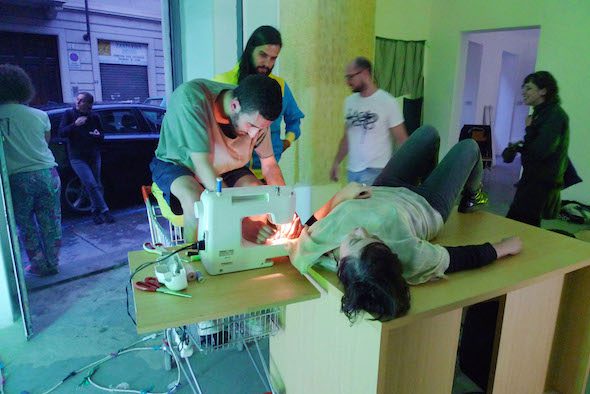
2008daughters: ‘Sew u!’, 2014 // Copyright: 2008daughters
RA: But usually you don’t design with someone in mind?
IG: Not usually, but it depends. Back in school we had to design with a person in mind, sometimes using a mannequin. If you didn’t, you would have been working on yourself, because either me or someone else has to fit it. I don’t work with mannequins anymore, I work with real people. I have to see it on the body. In school, I used to use my dad as a model for some pieces, like trousers and jackets. But now it is more about ‘every body’ for me.
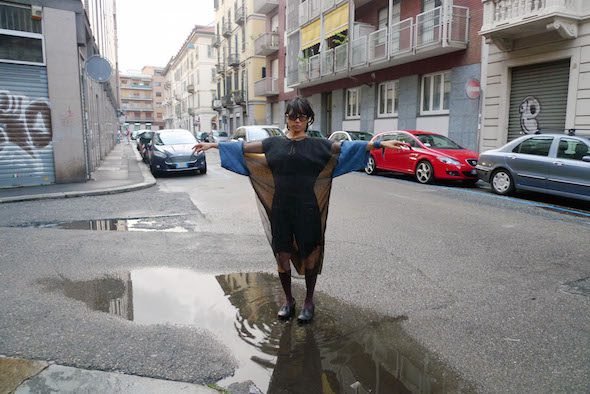
2008daughters: ‘Sew u!’, 2014 // Copyright: 2008daughters
RA: So your works are more one-off pieces, not necessarily for sale?
IG: Yes, most are. I also did some t-shirts and made about 2 editions of 10 of those, two different sizes. But I already noticed that they didn’t fit everyone. Friends were trying them on, and some said that they weren’t for them. Of course the pattern didn’t fit everybody. It’s not easy to produce something that fits everybody. Setting the prices for 2008daughters pieces resulted of a play with double numbers like 66, 77 or 222. The main aim for us is not to sell. I guess art and fashion are a bit different in that sense. Unless you produce editions.
RA: Is gender an important question for you?
IG: I don’t think about it in our work, but of course the designer in me knows you have different patterns for men and women, shoulder, back, waist. I don’t have a classical female body, so it’s easier for me to wear men’s or unisex clothes.
DF: We don’t want to define what we’re doing into a category. Binary logic is boring and lethal as male and female. When we’re producing clothes, we’re not thinking about who it’s for, they’re just for lovers. It’s not about an imposed form, and things are allowed to clash.
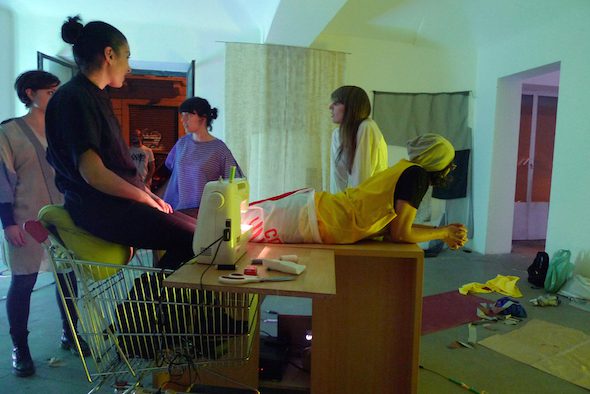
2008daughters: ‘Sew u!’, 2014 // Copyright: 2008daughters
RA: You seem to not be worried about the outcome of a process during a project or even the audience’s reaction. Does this way of working sometimes scare you?
IG: Well if friends don’t like it, I ask myself why. But with strangers, at first it doesn’t matter if their reaction isn’t good.
DF: Maybe there is a fear of not being honest with yourself. It’s not about the fear that someone else won’t like it, it’s about the fear that you weren’t honest and as a result haven’t produced an honest piece of work.
RA: You have very different backgrounds and you’re from different countries. What have you learned from each other as creatives?
DF: [laughs] A lot. For me I probably learned pragmatism from Isa.
IG: In the beginning, when I was going to Italy for several different projects, I learned that maybe you don’t have to know until the last minute what the work will be and accept that it’s never finished. For the performances, we never know who will show up, who is going to be there, it’s heavily influenced by the people. I didn’t necessarily learn that from Derek, but I learnt it doing what we do.
RA: As a designer, when you start a piece or collection you have an idea of the final look, so that sounds like a contradiction of how you actually work.
IG: And that’s both difficult and refreshing, because sometimes you can’t but you have to relax and say that maybe the outcome doesn’t matter, it will come out how it will come out. And also we can work each by ourselves, showing it each other and then we work on that and make some changes. But sometimes something more unexpected just emerges while doing it together.
RA: Why did you choose Berlin?
IG: It’s so multi-cultural, but what people sometimes forget is that it is still Germany. It’s not a crazy city, it’s still German. And while occasionally Germans can be crazy, they’re also very pragmatic and very organised. No one is in a hurry, but it’s also dangerous, because it can make you slow down.
DF: I was in London doing other projects and then I met someone here, and Isa was here. I mean I’m not in love with the city, but I’m also still discovering it. Living somewhere is different than coming to visit as a tourist. Maybe we’ll go somewhere else, perhaps even different directions. just like the chiaroscuro, the light produced with a plant, much like its shadows, our next move and what direction we’re going in, is difficult to predict.
























